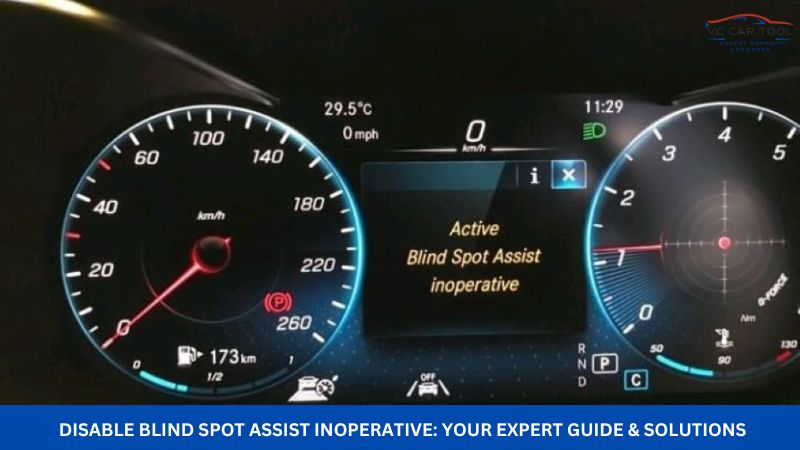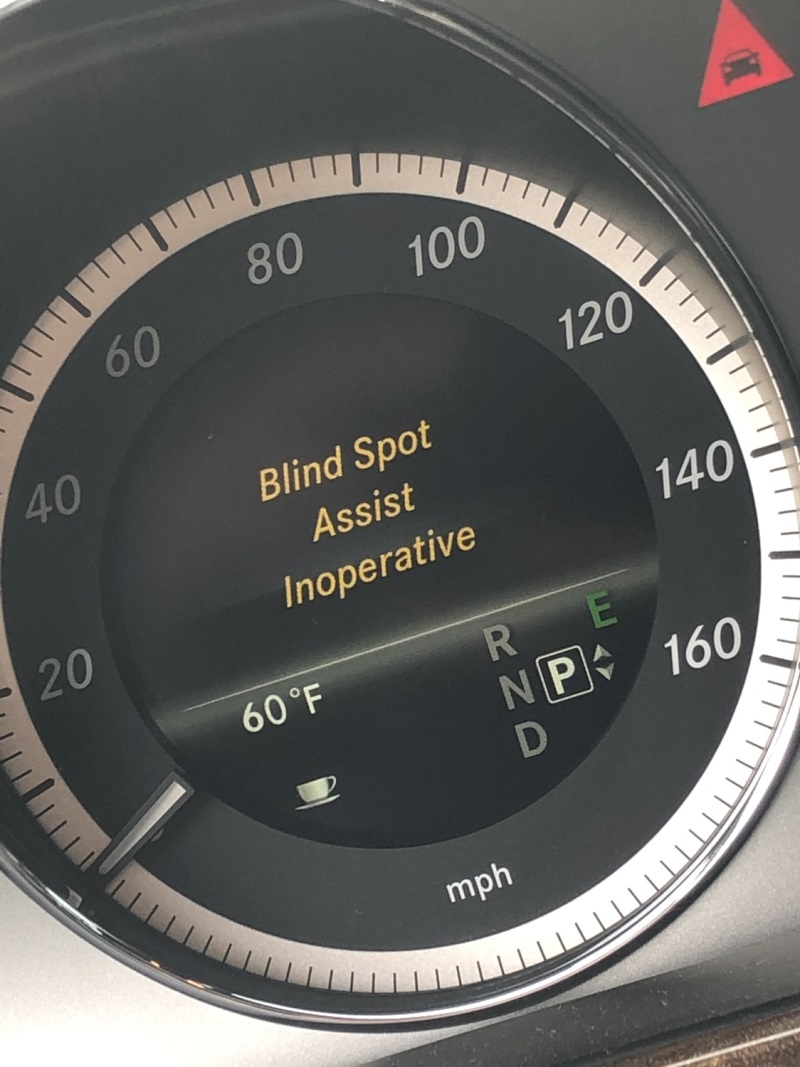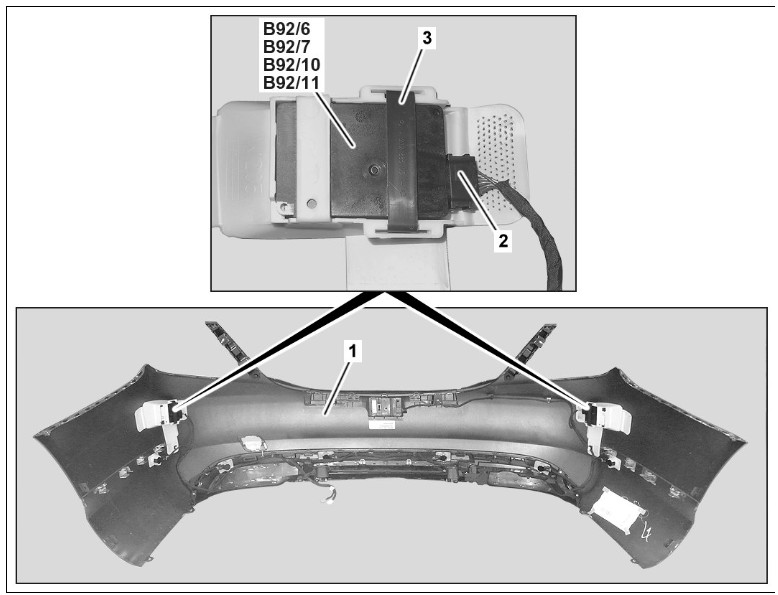Disable Blind Spot Assist Inoperative: Your Expert Guide & Solutions
Disable Blind Spot Assist Inoperative? This guide provides expert insights and actionable solutions to fix this issue, ensuring your Mercedes-Benz safety systems are fully operational. Stay informed with VCCarTool and learn how to restore your vehicle’s safety features.
If you’re unsure how to repair, diagnose, or program Disable Blind spot assist Inoperative errors, contact VCCarTool via WhatsApp: +1 (901) 414 – 1927 for assistance to avoid causing more serious errors.

1. Understanding Blind Spot Assist Inoperative
Blind Spot Assist is a crucial safety feature in modern vehicles. When the system displays an “Inoperative” message, it indicates a malfunction that needs immediate attention. Let’s explore common causes and effective solutions.
1.1 What Does “Blind Spot Assist Inoperative” Mean?
“Blind Spot Assist Inoperative” signifies that the vehicle’s blind spot monitoring system is not functioning correctly. This system typically uses radar sensors to detect vehicles in your blind spots, alerting you to potential hazards during lane changes. When inoperative, these alerts are disabled, compromising safety.
1.2 Why Is Blind Spot Assist Important?
According to the National Highway Traffic Safety Administration NHTSA, blind spot monitoring systems can reduce lane change accidents by up to 14%. These systems provide an extra layer of safety, particularly on busy highways.
1.3 Common Causes of Blind Spot Assist Failure
- Sensor Obstruction: Dirt, snow, or debris blocking the radar sensors.
- Sensor Malfunction: Physical damage or internal failure of the sensors.
- Software Issues: Glitches or outdated software affecting system performance.
- Wiring Problems: Damaged or loose wiring connections.
- Calibration Issues: Misalignment of sensors after a collision or repair.

2. Diagnosing “Blind Spot Assist Inoperative”
Accurate diagnosis is the first step toward resolving the “Blind Spot Assist Inoperative” issue. Here’s how to approach it.
2.1 Initial Checks You Can Perform
- Clean the Sensors: Locate the radar sensors, usually in the rear bumper, and clean them thoroughly.
- Restart the Vehicle: Turn off the engine, wait a few minutes, and restart the car to reset the system.
- Check for Error Messages: Note any specific error codes displayed on the dashboard, as these can provide clues to the problem.
2.2 Using Diagnostic Tools
For a more in-depth diagnosis, use an OBD-II scanner. These tools can read fault codes stored in the vehicle’s computer, helping pinpoint the exact cause of the issue.
Example Fault Codes:
- C151E: Left Blind Spot Sensor Malfunction
- C151F: Right Blind Spot Sensor Malfunction
- U0102: Lost Communication with Blind Spot Monitoring Control Module
2.3 When to Seek Professional Help
If initial checks and diagnostic tools don’t resolve the issue, it’s time to consult a professional. VCCarTool offers expert diagnostic services to quickly identify and fix complex issues. Contact us via WhatsApp: +1 (901) 414 – 1927 for immediate assistance.
 Mercedes blind spot detection sensor location
Mercedes blind spot detection sensor location
Mercedes blind spot detection sensor location.
3. Step-by-Step Guide to Fixing Blind Spot Assist Inoperative
Once you’ve diagnosed the problem, follow these steps to resolve the “Blind Spot Assist Inoperative” issue.
3.1 Cleaning and Inspecting Sensors
- Locate the Sensors: Typically found in the rear bumper corners.
- Clean Thoroughly: Use a soft cloth and mild detergent to remove dirt and debris.
- Inspect for Damage: Check for any physical damage, such as cracks or loose mountings.
3.2 Checking and Repairing Wiring
- Access Wiring Diagrams: Consult your vehicle’s service manual for wiring diagrams.
- Inspect Connections: Check for loose, corroded, or damaged connections.
- Repair or Replace Wires: Repair any damaged wires or replace them if necessary.
3.3 Software Updates and Resets
- Check for Updates: Use a diagnostic tool to check for software updates for the blind spot monitoring system.
- Perform a Reset: Follow the diagnostic tool’s instructions to reset the system after updating the software.
3.4 Sensor Replacement and Calibration
- Replace Faulty Sensors: If a sensor is malfunctioning, replace it with a new one.
- Calibrate the System: Use a diagnostic tool to calibrate the new sensor, ensuring it functions correctly.
3.5 Real-World Case Study
A customer reported “Blind Spot Assist Inoperative” on their Mercedes C-Class. Using VCCarTool’s remote diagnostic service (WhatsApp: +1 (901) 414 – 1927), we identified a faulty right rear sensor. After replacing and calibrating the sensor, the system was fully operational.
4. Preventing Future Issues
Preventing future issues is essential for maintaining the reliability of your blind spot assist system.
4.1 Regular Maintenance Tips
- Clean Sensors Regularly: Keep the radar sensors clean and free from obstructions.
- Check Wiring: Periodically inspect wiring connections for damage or corrosion.
- Software Updates: Ensure the system software is up to date.
4.2 Safe Driving Practices
- Avoid Collisions: Protect the rear bumper from impacts that could damage the sensors.
- Proper Parking: Be mindful of parking spaces to prevent sensor damage.
4.3 The Role of Professional Check-ups
Regular professional check-ups can identify potential issues before they become major problems. VCCarTool offers comprehensive diagnostic services to keep your vehicle in top condition. Contact us via WhatsApp: +1 (901) 414 – 1927 to schedule a check-up.
5. Advanced Troubleshooting for Blind Spot Assist Inoperative
When basic troubleshooting steps don’t resolve the issue, advanced techniques are required to diagnose and fix the problem effectively. These methods often involve specialized tools and a deeper understanding of the vehicle’s electronic systems.
5.1 Using Advanced Diagnostic Tools
Advanced diagnostic tools, such as the Mercedes-Benz XENTRY system or Autel MaxiSYS, provide in-depth access to the vehicle’s control modules. These tools can perform detailed system scans, live data monitoring, and component testing.
Key Features of Advanced Diagnostic Tools:
- System Scan: Identifies all fault codes across different modules.
- Live Data Monitoring: Real-time monitoring of sensor data to identify anomalies.
- Component Testing: Activates individual components to verify functionality.
- Calibration: Recalibrates sensors after replacement or adjustment.
5.2 Interpreting Live Data
Analyzing live data from the blind spot sensors can provide valuable insights into the system’s operation. Look for inconsistencies in sensor readings, such as erratic values or complete signal loss.
Example Live Data Parameters:
- Sensor Distance: Distance readings from each sensor.
- Signal Strength: Strength of the radar signal.
- Sensor Status: Indicates whether the sensor is active and functioning correctly.
5.3 Performing Component Tests
Component tests can help isolate faulty components within the blind spot assist system. These tests involve activating individual sensors and monitoring their response.
Example Component Tests:
- Sensor Activation: Activating the sensor to emit a radar signal.
- Signal Monitoring: Monitoring the sensor’s output signal for proper waveform and amplitude.
5.4 Addressing Communication Issues
Communication problems between the blind spot control module and other vehicle systems can cause the “Inoperative” message. Check the CAN (Controller Area Network) bus for any communication errors.
Common CAN Bus Issues:
- Wiring Problems: Damaged or shorted CAN bus wires.
- Module Failure: Faulty control module disrupting communication.
- Software Glitches: Software bugs causing communication errors.
5.5 Example: Resolving a Communication Error
A customer reported intermittent “Blind Spot Assist Inoperative” messages on their Mercedes-Benz E-Class. Using a diagnostic tool, we found a U0100 code, indicating a lost communication with the ECM Engine Control Module. After inspecting the CAN bus wiring and connectors, we found a corroded connector. Cleaning and securing the connector resolved the communication issue and eliminated the “Inoperative” message. Contact VCCarTool via WhatsApp: +1 (901) 414 – 1927 for similar expert solutions.
6. The Economic Impact of Ignoring Blind Spot Assist Issues
Ignoring “Blind Spot Assist Inoperative” messages can have significant economic consequences.
6.1 Increased Accident Risk
According to the Insurance Institute for Highway Safety IIHS, vehicles with functioning blind spot monitoring systems have a 12% lower crash rate. Driving without this feature increases the risk of accidents, leading to higher insurance premiums and potential repair costs.
6.2 Potential Legal Liabilities
In the event of an accident, driving with a known malfunctioning safety system can expose you to legal liabilities. If the accident is deemed to be caused by the inoperative blind spot assist, you may be held responsible for damages and injuries.
6.3 Decreased Vehicle Resale Value
A malfunctioning blind spot assist system can reduce your vehicle’s resale value. Potential buyers may be hesitant to purchase a vehicle with known safety issues, or they may demand a lower price to compensate for the cost of repairs.
6.4 Cost-Benefit Analysis of Repairing the System
Repairing the blind spot assist system is a cost-effective investment in the long run. The cost of repairing or replacing sensors and wiring is typically less than the potential expenses associated with accidents, legal liabilities, and decreased resale value.
| Expense | Estimated Cost |
|---|---|
| Sensor Replacement | $200 – $500 per sensor |
| Wiring Repair | $100 – $300 |
| Diagnostic Service | $80 – $150 |
| Accident-Related Expenses | $5,000 – $20,000+ |
| Decreased Resale Value | $500 – $2,000 |
7. Choosing the Right Repair Service
Selecting the right repair service is crucial for ensuring the “Blind Spot Assist Inoperative” issue is resolved effectively.
7.1 Factors to Consider When Choosing a Repair Service
- Expertise and Experience: Look for a repair service with expertise in Mercedes-Benz vehicles and blind spot assist systems.
- Diagnostic Capabilities: Ensure the service has advanced diagnostic tools and trained technicians.
- Customer Reviews and Testimonials: Check online reviews and testimonials to assess the service’s reputation.
- Warranty and Guarantees: Inquire about warranties and guarantees on parts and labor.
7.2 Why VCCarTool is Your Best Choice
VCCarTool offers unparalleled expertise and service for diagnosing and repairing blind spot assist systems. Our team of certified technicians uses state-of-the-art diagnostic tools to quickly identify and resolve issues. We provide transparent pricing, reliable repairs, and excellent customer service. Contact us via WhatsApp: +1 (901) 414 – 1927 or email [email protected] to schedule a diagnostic appointment. You can also visit our website at vccartool.com for more information.
7.3 The Benefits of Remote Diagnostic Services
VCCarTool‘s remote diagnostic services offer a convenient and cost-effective way to diagnose “Blind Spot Assist Inoperative” issues. Our technicians can remotely access your vehicle’s computer, perform diagnostic scans, and provide expert guidance, saving you time and money.
8. The Future of Blind Spot Assist Technology
Blind spot assist technology is continuously evolving, with new features and enhancements being introduced to improve safety and convenience.
8.1 Emerging Trends in Blind Spot Monitoring
- Enhanced Sensor Technology: New radar and camera sensors offer improved detection range and accuracy.
- Integration with Advanced Driver Assistance Systems ADAS: Blind spot assist is becoming integrated with other ADAS features, such as lane keeping assist and adaptive cruise control.
- Artificial Intelligence AI: AI algorithms are being used to analyze sensor data and provide more accurate and timely alerts.
8.2 The Impact of Autonomous Driving
As autonomous driving technology advances, blind spot monitoring systems will play an increasingly important role in ensuring safety. These systems will provide critical data to autonomous vehicles, helping them navigate safely in complex driving environments.
8.3 How to Stay Updated on the Latest Technology
Staying informed about the latest advancements in blind spot assist technology is essential for maintaining your vehicle’s safety and performance. VCCarTool provides regular updates and insights into emerging trends in automotive technology. Visit our website at vccartool.com or contact us via WhatsApp: +1 (901) 414 – 1927 to learn more.
9. Additional Safety Features to Consider
While blind spot assist is an essential safety feature, it’s important to consider other systems that can enhance driving safety.
9.1 Lane Departure Warning Systems
Lane departure warning systems alert you if you unintentionally drift out of your lane. These systems use cameras to monitor lane markings and provide visual or audible warnings.
9.2 Adaptive Cruise Control
Adaptive cruise control automatically adjusts your vehicle’s speed to maintain a safe following distance from the vehicle ahead. This feature can help reduce driver fatigue and prevent accidents.
9.3 Automatic Emergency Braking AEB
Automatic emergency braking systems can automatically apply the brakes to prevent or mitigate collisions. These systems use radar and cameras to detect potential hazards and can significantly reduce the severity of accidents.
9.4 The Synergy of Safety Systems
Combining multiple safety systems can provide a comprehensive safety net, reducing the risk of accidents and injuries. By investing in these technologies and ensuring they are functioning correctly, you can enhance your driving safety and protect yourself and others on the road.
If you’re experiencing issues with your blind spot assist system or any other safety features, don’t hesitate to contact VCCarTool via WhatsApp: +1 (901) 414 – 1927 for expert assistance.
10. Your Next Steps
Addressing a “Blind Spot Assist Inoperative” message promptly is vital for maintaining your vehicle’s safety and performance. By following the steps outlined in this guide, you can diagnose and resolve the issue effectively.
10.1 Immediate Actions to Take
- Clean the Sensors: Ensure the radar sensors are clean and free from obstructions.
- Check for Error Messages: Note any specific error codes displayed on the dashboard.
- Contact VCCarTool: If the issue persists, contact us via WhatsApp: +1 (901) 414 – 1927 for expert assistance.
10.2 Long-Term Maintenance Strategies
- Regular Maintenance: Schedule regular maintenance appointments to ensure your vehicle’s systems are functioning correctly.
- Software Updates: Keep your vehicle’s software up to date to prevent software-related issues.
- Safe Driving Practices: Adopt safe driving practices to minimize the risk of accidents and damage to your vehicle.
10.3 How VCCarTool Can Help You
VCCarTool is your trusted partner for all your automotive diagnostic and repair needs. Our team of certified technicians, state-of-the-art tools, and commitment to customer satisfaction make us the best choice for resolving “Blind Spot Assist Inoperative” issues. Contact us today via WhatsApp: +1 (901) 414 – 1927, email [email protected], or visit our website at vccartool.com to learn more and schedule a service appointment.
FAQ: Disable Blind Spot Assist Inoperative
1. What does “Blind Spot Assist Inoperative” mean?
It means the blind spot monitoring system is not working, disabling alerts about vehicles in your blind spots.
2. What are common causes of this issue?
Common causes include dirty sensors, sensor malfunction, software glitches, wiring problems, or calibration issues.
3. Can I fix this issue myself?
Yes, you can start by cleaning the sensors and restarting the vehicle. For more complex issues, professional help is recommended.
4. How do I clean the blind spot sensors?
Locate the sensors in the rear bumper corners, and use a soft cloth and mild detergent to clean them.
5. What tools are needed for diagnosis?
An OBD-II scanner can read fault codes. Advanced tools like Mercedes XENTRY offer more detailed diagnostics.
6. When should I seek professional help?
If initial checks and diagnostic tools don’t resolve the issue, consult a professional like VCCarTool via WhatsApp: +1 (901) 414 – 1927.
7. How can VCCarTool help me?
VCCarTool offers expert diagnostic and repair services, including remote diagnostics. Contact us via WhatsApp: +1 (901) 414 – 1927.
8. What are the benefits of regular maintenance?
Regular maintenance prevents issues by keeping sensors clean, checking wiring, and ensuring software is updated.
9. What other safety features should I consider?
Consider lane departure warning systems, adaptive cruise control, and automatic emergency braking for enhanced safety.
10. How can I stay updated on the latest technology?
Visit vccartool.com or contact VCCarTool via WhatsApp: +1 (901) 414 – 1927 for regular updates on automotive technology.
Remember, if you’re unsure how to repair, diagnose, or program Disable Blind spot assist Inoperative errors, contact VCCarTool via WhatsApp: +1 (901) 414 – 1927 for assistance to avoid causing more serious errors.
